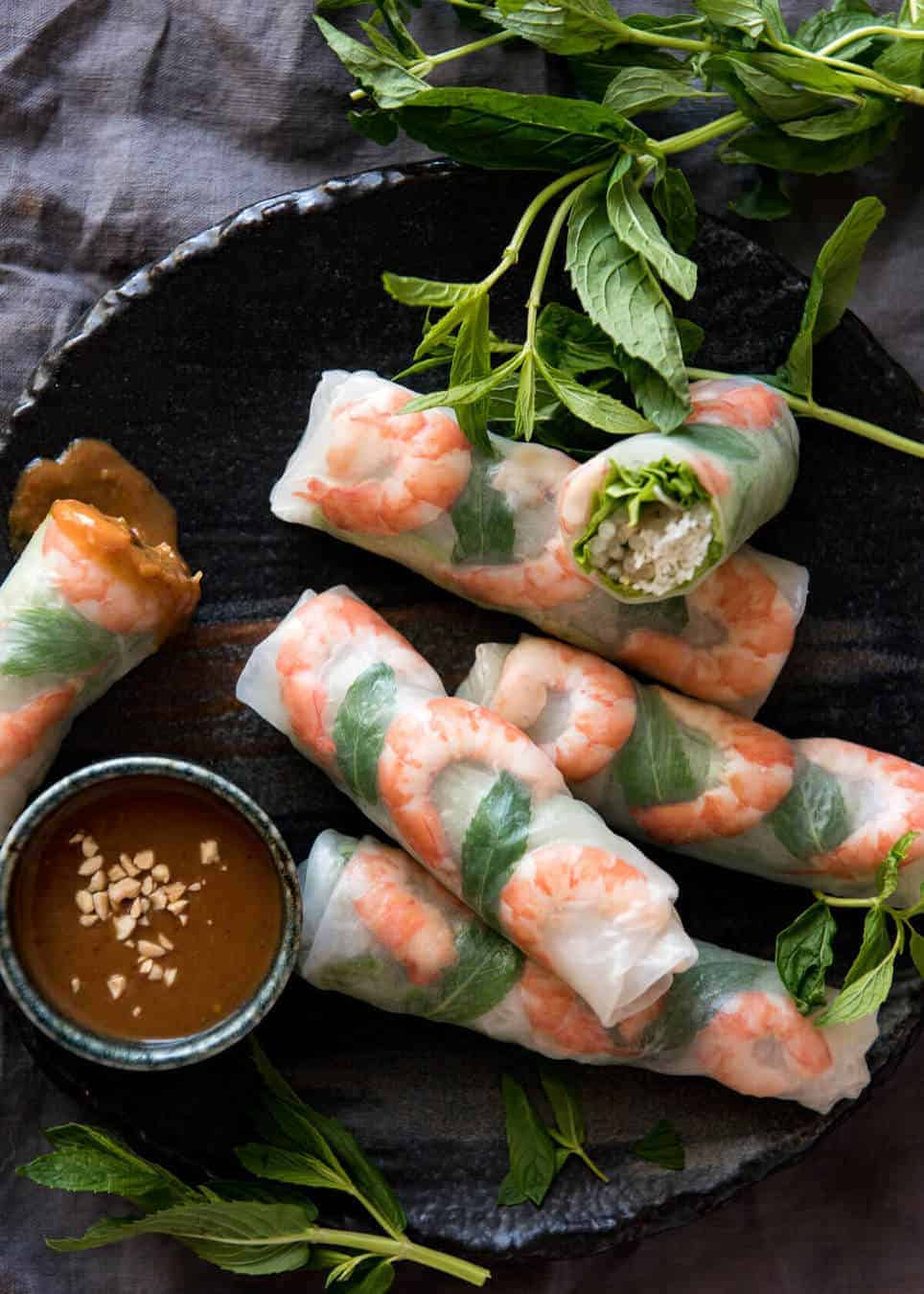Wholesome Family Fun with Recipe Rice Paper Rolls
Hey there, awesome parents! Are you looking to whip up something nutritious, delicious, and most importantly, fun for the whole family? Then buckle up because rice paper rolls are about to be your new go-to recipe for a kitchen cooking extravaganza with your kiddos!
These delightful little rolls are not only a joy to make but packed with health benefits that will keep your family fueled and happy. Perfect for little hands eager to help, and customizable for the pickiest of eaters, rice paper rolls are the ultimate parent win-win. So, let’s roll up our sleeves, get creative with fillings, and embark on a culinary adventure together!
What Are Recipe Rice Paper Rolls?
Rice paper rolls, also known as summer rolls or fresh spring rolls, are a traditional Vietnamese dish usually made with shrimp, fresh veggies, vermicelli noodles, and herbs all wrapped in a translucent rice paper. But here’s the magic: they’re a blank canvas, waiting for you and your mini-chefs to paint with your favorite ingredients!
Anatomy of a Perfect Rice Paper Roll
- Rice Paper: The star of the show, this is a thin wrapper made from rice flour that transforms from crisp to pliable when dipped in water.
- Proteins: Choose from lean meats, shrimp, tofu, or even egg slices! Anything goes here, as long as it’s sliced thin for easy rolling.
- Veggies: Lettuce, cucumber, carrot, and bell peppers add crunch, while avocado adds creaminess. Play around with the colors and textures!
- Herbs: Fresh herbs like mint, cilantro, or basil will elevate your rolls to a new level of freshness.
- Noodles: Vermicelli rice noodles give body to your rolls and are super kid-friendly.
- Sauces: Think hoisin, peanut sauce, or a simple mix of soy sauce and lime. These are perfect for dipping and can be adjusted for spice levels.
Getting Started: Ingredients & Prep Work
Alright! Before we dive into the art of rolling, let’s make sure we have everything ready. Ingredients are key. Here’s a handy list to get you started:
Essential Ingredients
- Fresh rice paper sheets.
- Your choice of proteins, thinly sliced and pre-cooked if necessary.
- Julienne or thinly sliced vegetables like carrots, cucumbers, and bell peppers.
- A variety of herbs such as mint, cilantro, or basil leaves.
- Cooked vermicelli rice noodles, cooled.
- Dips and sauces for a flavor burst.
Preparation Tips
- Slice all your proteins and veggies beforehand.
- Put herbs in a bowl of cold water, so they stay fresh and perky.
- Cook vermicelli noodles according to the package, then rinse in cold water and drain.
- Set up a dipping station with warm water for the rice paper sheets.
- Clear a rolling area on your kitchen counter and have a tray ready for the finished rolls.
The Rolling Party: Turn Cooking into a Fun Activity
Now that your ingredients are lined up, it’s time to get those little hands busy. Children love the hands-on experience of making rice paper rolls. Not only is it a sensory pleasure (hello, squishy noodles and cool, crisp veggies!), but it’s also a chance to practice fine motor skills and creativity. Plus, it’s a fabulous opportunity for sneaky learning—think measuring ingredients, understanding nutrition, and mastering the delicate art of not overstuffing a roll (we’ve all been there).
Gather the troops, assign tasks based on age and skill level, and get ready for some giggles and possibly a little mess (which is part of the fun, right?). Whether it’s spreading out the rice paper, laying down the sticks of cucumber, or the ultimate test of rolling everything up, there’s a job for everyone.
Remember, the beauty of rice paper rolls is in their versatility. Encourage your kids to pick and choose from the ingredients, making each roll a reflection of their personality and taste buds. Are you dealing with a little one who’s not a fan of veggies? Challenge them to include at least two types in their roll and dip it in a tasty sauce—seeing their creation might just tempt them to take a bite.
In the next section, we’ll dive into the step-by-step rolling process, perfecting our technique, and exploring delightful dipping sauces that might just steal the show. So stay tuned, the rolling fun has just begun!

5 Things Parents Should Know When Preparing Rice Paper Rolls with Kids
1. Master the Rice Paper Soak
Before the rolling fun begins, it’s crucial to get the rice paper soaked just right. Not too soggy, and not too stiff. Here’s a tip: dip the rice paper in warm water for about 5-10 seconds, then lay it flat on a clean damp cloth. It will continue to soften as you add the fillings, making it flexible enough for rolling without tearing.
2. Set Up a Kid-Friendly Filling Station
Kids love variety and being able to choose what goes into their rolls. Set out bowls of ingredients in the order they’ll be placed on the rice paper. For stress-free fun, make sure everything is within reach and there’s enough space for multiple little hands to work at the same time.
3. Embrace the Imperfect Roll
Let’s be realistic, not every roll will be picture-perfect, and that’s okay! Celebrate the wonky ones too. The important part is that the kids are having fun and learning. They’ll get better with practice, and messy rolls are just as tasty as the neat ones!
4. Balance Nutrition and Fun
Yes, we want our kids to eat healthy, but it’s equally important for them to enjoy the food. Rice paper rolls can be packed with a wide range of colorful vegetables, lean proteins, and herbs, making them a balanced meal. Get your kids involved in selecting their own combinations to get them more invested in eating their creations.
5. Preparing for the Cleanup
Have a game plan for the inevitable cleanup. Whether it’s assigning tasks like “drying station” for post-rolled goods or having little ones help clear the counter, keeping the cleanup part of the activity helps instill responsibility and care for their workspace.
The Rolling Technique: A Step-by-Step Guide
Rolling perfect rice paper rolls may seem daunting at first, but with some patience and practice, you and your kiddos will be rolling like pros in no time. Here’s a foolproof guide to follow:
- Soak your rice paper in warm water for 5-10 seconds until it’s just starting to soften. Lay it flat on a damp cloth.
- On the lower third of the rice paper, start with a few herb leaves, giving the roll a fresh layer at the center.
- Add your other fillings—some noodles, a sprinkle of veggies, and your chosen protein. The key is to not overfill; too much and the roll won’t close!
- Carefully fold the edge closest to you over the fillings, tucking in tightly.
- Fold in the sides like you would a burrito. This keeps the fillings secure and helps give the roll its shape.
- Continue to roll away from you until the rice paper seam seals on its own. Voila! You have your roll.
Dipping Sauces Galore! Making Flavors Pop
What’s a rice paper roll without a dipping sauce to complement it? Here’s where you can introduce new flavors to your family’s palate. Start with simple sauces like soy sauce with a drop of honey or a creamy peanut butter dip. As kids explore and develop their tastes, you can venture into tangier or spicier realms. Have your junior chefs help mix up the sauces and decide on the flavors—it’s the perfect finale to this meal-making adventure!
With these tips and steps, you’re well on your way to making recipe rice paper rolls a regular fun, and healthy cooking activity in your household. Enjoy the bonding, the tasting, and the whole experience, knowing you’re creating more than just food—you’re making memories that will last a lifetime.
For more great articles please see here. For more information see here
Disclaimer
The articles available via our website provide general information only and we strongly urge readers to exercise caution and conduct their own thorough research and fact-checking. The information presented should not be taken as absolute truth, and, to the maximum extent permitted by law, we will not be held liable for any inaccuracies or errors in the content. It is essential for individuals to independently verify and validate the information before making any decisions or taking any actions based on the articles.




